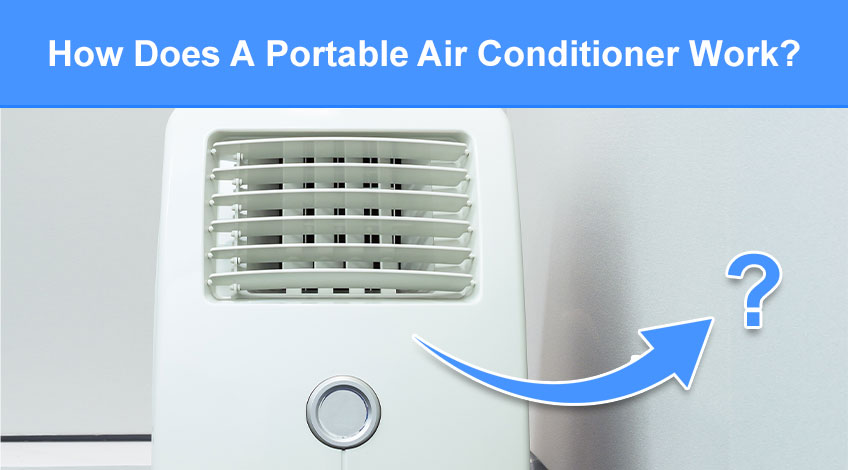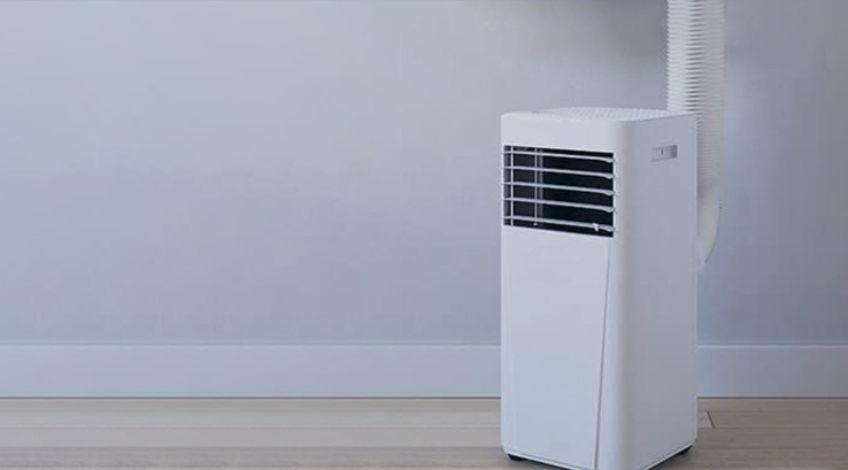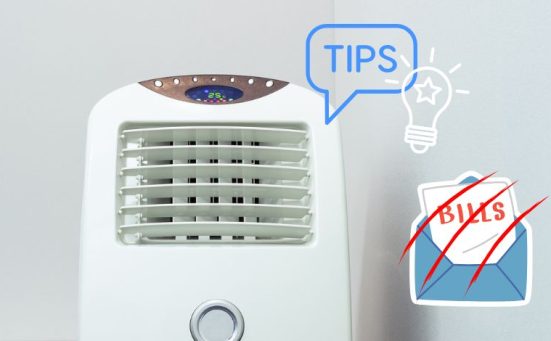
How Does A Portable Air Conditioner Work? (UK portable aircon explained)
With our Summers getting warmer it can be difficult to keep cool indoors during those hot Summer months. Living in the UK there’s little point going to all of the trouble and expense of installing a permanent air conditioner unit. However, a portable aircon unit could offer the perfect alternative.
A portable air conditioner doesn’t need to be installed by a professional and as they only work in the room they’re situated in, they don’t waste cold air.
If you’ve ever wondered just how a portable AC works, keep reading. Because in this article we’ll explain the hows, whys and wherefores of portable aircon units.
How Do Portable Air Conditioners Work?
Portable air conditioners work by removing warm air from the room and cooling it to the selected temperature and then pumping the cool air back into the room. The excess heat is simultaneously pumped outside of the room via an exhaust.
For a portable air conditioner unit to work, it relies on four components which are;
- A Refrigerant
The heated air passes over the cooled refrigerant which absorbs heat from the air. - A Compressor
The compressor is used to compress the refrigerant which allows condensation to take place. - An Evaporator
This is where the refrigerant is cooled so that when air is passed over the evaporator it is cooled down. - A Fan
The fan draws the warm air into the A/C from the room and expels that warm air outside.
The Way It Works
All portable air conditioners have two radiators, one will get cold and the other will get hotter.
Due to the laws of thermodynamics, the temperature will alway want to become stable and at an equal value.
Which means the cold radiator will absorb heat from the room while the hot radiator will send that heat outside of the room (via the exhaust hose).
How Is This Heat Transfer Made Possible?
Running through both radiators are some copper pipes that are closed in a loop.
The copper pipe comes from the compressor, into the evaporator, then through an expansion valve, and then into the condenser on a continuous cycle.
The copper coil on the cold side is called the evaporator. The copper coil on the hot side is called the condenser. The refrigerant flows through this copper pipe circuit.
There are also two other important components which are the compressor and the expansion valve. The compressor increases the pressure of the refrigerant inside the tubes. High pressure goes to the hot radiator and low pressure goes to the cold coil.
The higher the pressure on the refrigerant, the hotter the refrigerant gas will become. The heat created will travel on towards the condenser. But because the heat in the pipe is hotter than the outside temperature, the heat will go outside (remember those laws of thermodynamics).
To help move the hot air outside, there is a fan to blow it. There are also a number of aluminium fins attached to the copper pipe coils which increase the surface area which allows more heat to be sent outside at a faster rate.
As the heat is ejected from the copper pipes, the gas inside the pipe is losing heat as well and cooling down. This makes the hot liquid turn into a cool liquid and as it passes through the expansion valve it turns back into a gas. This gas is far colder than in its liquid state.
So to put it simply:
- The cold refrigerant absorbs the heat from the room which makes the refrigerant slightly hotter.
- As it passes through the compressor it heats up further as it is pressurised by the compressor.
- As it reaches the condenser, the heat is ejected to the outside (via an exhaust hose) which lowers the temperature of the refrigerant.
- Which turns it back into a cooler liquid.
- As it passes through the expansion valve, the refrigerant is turned back into a gas at an extremely low temperature.
- The process is repeated continuously.
On the cold radiator, part of the heat is absorbed as condensation and the vapour turns to water which is collected in a reservoir inside the A/C unit. This will need to be emptied periodically.
Although most modern portable A/Cs use a self-evaporation process which will remove that moisture along with the warm air in the exhaust hose.

Single Hosed Or Dual Hosed?
There are some portable aircon units that have two hoses which are known in the trade as dual hosed units.
These dual hosed units have one hose that draws air from outdoors to cool the compressor and coils inside the unit. While the other hose exhausts the warm air to the outside.
Most nowadays are single hose units which extract the warm air from the room and cool it down using the condenser and coils inside the unit. The cooler air is then blown back into the room whilst the warm air is ejected via the single hose which is the exhaust hose.
Can The Hose Be Extended On A Portable A/C Unit?
This is one of those questions we’re often asked and while it is technically possible to extend the exhaust hose, it is not recommended.
This is because the exhaust hose has been designed to work exactly as it should with that particular A/C unit.
Extending the hose will reduce the efficiency of the unit and in some cases, cause the unit to overheat.
The Correct Way To Vent A Portable Aircon
All portable A/Cs will have an exhaust hose or vent hose which will have to be placed outside of the room. This is usually achieved by placing the hose through an open window.
To achieve an efficient heat exchange, you’ll need to seal the area around the vent hose as you don’t want the warm air re-entering the room once it has been removed.
This is usually achieved using a window seal kit. If you don’t have a window seal kit or if it doesn’t create a perfect seal, you can make your own using plywood or polystyrene.
If there is no window access, you could vent your portable A/C via a roof, wall or a door. The important thing is that the warm air is ejected from the room.
What Maintenance You Need To Do On Portable ACs
To keep your portable A/C unit running smoothly and efficiently it needs to be maintained correctly. This will include cleaning the air filters and the exterior of the unit.
You will also need to check whether there’s a water tank at the bottom of the unit. If there is, this will need to be emptied periodically.
When the A/C unit is not in use, it should be stored as per manufacturer’s instructions to preserve the warranty.
Does It Cost A Lot To Run
Portable air conditioners can be quite expensive to run when compared to a bladeless fan, but the actual cost depends on many factors such as: the unit’s wattage, BTU rating, the size of the room, the ambient air temperature, the cost of electricity per unit and more.
Using a 1200 watt portable air conditioner as an example, it would cost around 41p per hour to run in the UK, based on the current electricity prices of 34p per unit. However, a 2500 watt unit would cost approximately 85p per hour to run on the same energy tariff.
It’s important to consider the value of keeping cool and the running costs when deciding whether to buy a portable aircon unit.
Frequently Asked Questions
Not all portable air conditioners have to be vented out a window, if you don’t have access to a window you could vent the A/C through a wall, ceiling, door, chimney or even a tumble dryer vent.
If you cannot vent your portable air conditioner through a window, you could vent it through a door, wall, ceiling, tumble dryer vent or chimney.
You do not need to put water in a portable air conditioner unit. However there are some that are known as swamp coolers (evaporative A/Cs) which do need to be filled with water or ice.
A portable air conditioner can work without a hose but only as a dehumidifier and it will heat the room up not cool it down.
A portable air conditioner can run continuously 7 days a week 52 weeks of the year without it ever overheating or shortening its lifespan. However, it will need to be turned off occasionally for general maintenance, such as cleaning the filters etc.
Also, follow us on Pinterest ...



